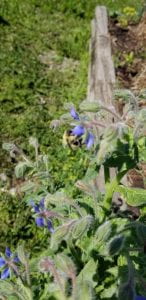 This Spring, the Master Gardener Volunteers in Clermont County are creating a straw bale demonstration garden at the Clermont County Fairgrounds. Using 22 straw bales, the MGVs are planting a variety of vegetables including tomatoes, peppers, potatoes, squash, cucumbers, pumpkins, beans, radishes, carrots, and lettuce. The bales are surrounded by herbs and flowers.
This Spring, the Master Gardener Volunteers in Clermont County are creating a straw bale demonstration garden at the Clermont County Fairgrounds. Using 22 straw bales, the MGVs are planting a variety of vegetables including tomatoes, peppers, potatoes, squash, cucumbers, pumpkins, beans, radishes, carrots, and lettuce. The bales are surrounded by herbs and flowers.
All vegetables will be donated to within the county. Let’s hope for a bountiful harvest!
The MGVs will be collecting data throughout the growing season so they can educate others in doing successful straw bale gardening. Come visit the demonstration straw bale garden at the Clermont County Fairground during the fair July 25-31!
Advantages to straw bale gardening are:
- Raises heights of beds making it easier on your back
- No weeding needed
- Low startup cost
- Extended growing season
- Impossible to over water
- Easy to move location of your garden each year
- Alternative to poor soil
- Holds moisture well
- Creates loads of A+ compost
- Prevents disease issues
- No heavy work i.e., tilling
- Minimum pests
Tips for successful straw bale gardening include:
- Use straw bales, do not use hay bales
- Place bales in full sun and near a water source
- Position bales north to south with no more than two rows side by side
- Cut side of the bale is up with strings on the side
- Condition each bale
Conditioning is the process of getting the straw bales to compost internally so they will support plant growth. The process takes about 2 weeks and involves spraying the bales to get water and fertilizer deep inside the bales so they can start to “cook”.
Schedule for conditioning the bales:
Days 1-3-5: Water into each bale ½ cup of lawn fertilizer high in nitrogen (i.e., 20-0-4, 46-0-0) with no pesticides nor slow-release features. (Water on days 2 and 4.)
Day 6: Water
Days 7-8-9: Water into each bale ¼ cup of same lawn fertilizer high in nitrogen
Day 10: Water into each bale 1 cup of i.e.,10-10-10 or 12-12-12- fertilizer free of pesticides
Day 11: Gather plants, seeds, and potting soil, while allowing bales to rest.
Day 12: Plant
It is essential that the bales be conditioned during this short period so that the bacteria inside the bales are activated and begin to digest the straw; making nitrogen and other nutrients available to the plants.
After bales are conditioned, plant seedlings or seeds in bed of potting mix. Water daily and enjoy your crop. At the end of the season, bales turn into clean compost for other gardens or as mulch.
For more information on straw bale gardening, check out Joel Karsten’s book entitled Straw Bale Gardens Complete
 It’s time for Clermont County Master Gardeners Demonstration Garden weekly update. Last week brought high humidity with temperatures in the 80’s and 90’s all week. The pollinators in the gardens were busy. There were many varieties of butterflies spotted in the gardens as well. Lots of produce was harvested from the gardens last week. Last weeks produce was used for OSU canning classes and the rest is being donated to the Owensville Senior Center. The following is as list of produce and their weights harvested from the gardens last week and updated pictures of the gardens:
It’s time for Clermont County Master Gardeners Demonstration Garden weekly update. Last week brought high humidity with temperatures in the 80’s and 90’s all week. The pollinators in the gardens were busy. There were many varieties of butterflies spotted in the gardens as well. Lots of produce was harvested from the gardens last week. Last weeks produce was used for OSU canning classes and the rest is being donated to the Owensville Senior Center. The following is as list of produce and their weights harvested from the gardens last week and updated pictures of the gardens:




























